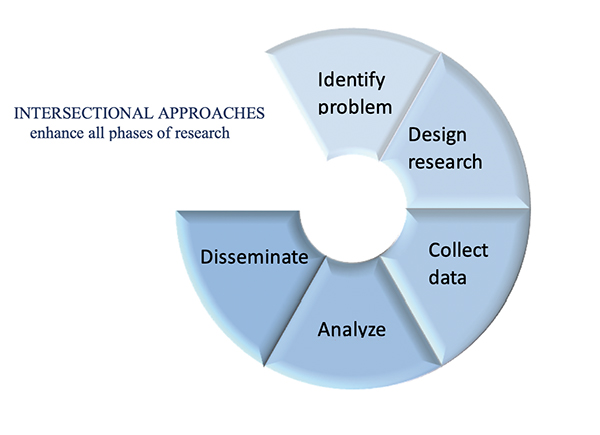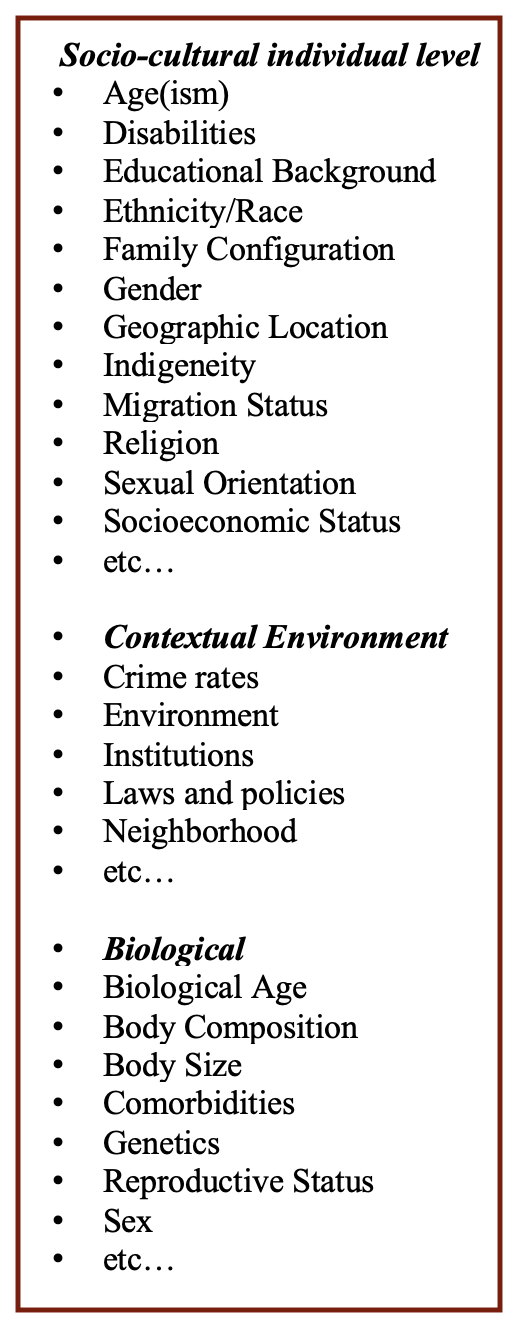
 Identify problem
Identify problem
Intersectional approaches may be relevant in studies involving human subjects. While sex and gender are important concepts to consider (see Analyzing Sex; Analyzing Gender), they are shaped by other social and biological factors. The way the research problem is formulated will determine which intersecting variables are required for analysis. The most important categories, factors and relationships cannot be determined a priori, but emerge during the process of investigation (Hankivsky, 2014).
Before beginning a study, researchers should conduct systematic literature searches to identify factors and categories of potential relevance. These categories and factors can be biological, socio-cultural or psychological characteristics of users, customers, participants, experimental subjects or cells (see box). Even intersecting factors, such as diet or genetic variability, may be important to consider. Such factors may reveal sub-group differences among males and females that would have been obscured by using only sex as a variable (see Case Study: Nutrigenomics).
In this phase, it is also important to consider the social contexts, including societal, institutional and community-level circumstances (e.g. laws, policies, healthcare providers, school systems, law enforcement, religious institutions, crime rates) that shape people’s life experiences, opportunities and choices in different ways depending on their gender, race, socio-economic status, sexuality, geographic location, etc. (Bowleg, 2012; Hankivsky, 2014).
Finally, it may be relevant to consider whose practical knowledge or experience is relevant to your project. Involving diverse groups of research subjects or potential end users in the research process (from problem formulation to research design) may sharpen the intersectional analysis and lead to more inclusive solutions (see Method: Co-Creation and Participatory research).
Intersectional research should be designed to illuminate the multiplicative effects of different but interdependent categories and factors. Determine which methods (qualitative, quantitative or mixed-method) are best suited for examining the intersecting variables of relevance to your project. Qualitative approaches (e.g. focus groups, document analysis, interviews and observations) can provide detailed insights into the complex web of factors, processes and relationships that shape people’s identities, opportunities and practices. Quantitative methods (e.g. survey questionnaires, social-media data, product purchases and register data) allow the researcher to examine similarities and differences across groups and subgroups, and may reveal how such similarities and differences vary by social context and evolve over time (Else-Quest and Hyde, 2016; Bowleg, 2008; Shields, 2008). In mixed-method designs, qualitative methods may be deployed to explore which intersectional categories, factors and relationships to examine in a subsequent quantitative analysis. Qualitative methods, however, may also be used to obtain a deeper understanding of salient interactions and relationships identified in a preceding quantitative analysis. A quantitative analysis, for example, may reveal unexpected differences between women and men that cannot be explained by gender or socioeconomic status alone, such as women of high socioeconomic status having similar health outcomes to those of men of low socioeconomic status (Sen et al., 2010). In this case, a qualitative follow-up study may help tease apart the underlying processes and mechanisms that drive the observed differences and similarities.
Consideration should always be given to the potentially dynamic nature of the intersectional categories and factors in focus. The importance of different categories and factors may vary by social context, and may change over time (Hankivsky, 2014). In quantitative research, such variations could be examined using geospatial analysis or longitudinal designs (Weber et al., 2019; Warner & Brown, 2011).
Finally, researchers using qualitative interviews or surveys should inspect their questions and categories for misguided or stereotypical assumptions before initiating the data collection. Extensive piloting and/or cognitive interviews with the target population may improve the study’s validity and reliability, and make data collection more effective. Collect dataApplying an intersectional approach presupposes data collection on factors intersecting with sex and gender (e.g. ethnicity, religion, sexual behavior, lifestyle, socioeconomic status, disability, gender categories relevant to transgender people, etc.).
The attention to individual-level categories and characteristics should be complemented by a focus on group-level factors (e.g. at the household, neighborhood, institutional, regional, state or national level). Again, the relevant variables to include will depend on the problem identified for study. At the neighborhood level, it may be relevant to include measures of air quality, crime rates, population density or housing-unit occupancy rates, etc. At the state and national levels, it may be relevant to account for factors such as healthcare policy schemes, parental leave policies or transgender rights legislation (Bowleg & Bauer, 2016).
In quantitative research, calculate the minimum sample size required for each group included in your analysis to allow for meaningful statistical analysis (Rouhani, 2014). Strategic oversampling of some groups may be necessary to allow sufficient statistical power for cross-group comparisons and interaction analyses. Respondent-driven sampling (Heckathorn, 1997) and time-space sampling (MacKellar et al., 2007) can be used to recruit marginalized or hidden populations that are difficult to access through traditional sampling methods (Bowleg & Bauer, 2016).
In qualitative research, the sample should be heterogeneous enough to capture the various intersecting positions of relevance to the research problem.
Analyze dataAn intersectional analysis seeks to illuminate the multiplicative effects of different but interdependent categories and factors.
Quantitative research should move beyond an additive focus on main effects (e.g. estimating separate effects for gender, race and sexual orientation) to examine how the variables in focus intersect (Bauer, 2014; Hancock, 2007; Bowleg & Bauer, 2016).
Multilevel models (e.g. hierarchical linear modelling) can be employed to tease out the effects of individual-level variables and group-level factors on a given outcome (e.g. hospital setting, neighborhood, state or occupation).
In regression models, interaction terms may be used to probe how respondents at particular locations in the intersection of two or more categories (e.g. a gay black man, or a straight Asian woman) vary on a given outcome. Multiple main effects may also be used to examine such variations if dichotomous variables are computed for each of the intersecting categories of interest (Sen et al., 2010). A medical study, for instance, examining main effects for intersecting categories related to sex and race found that in-hospital mortality for myocardial-infarction patients showed little variation for white females, white males and black males but was higher for black females (Vaccarino et al., 2005). This important finding could have been overlooked had the study restricted its focus to two main effects (sex and race) rather than including dichotomous variables for each of the four locations in the intersection (white male, white female, black male and black female) (see also Sen et al., 2010).
Qualitative analyses will often be exploratory in nature and should offer rich descriptive accounts of the various categories, factors and processes that intersect to shape people’s identities, opportunities and practices in a given context (Hunting, 2014). Such an analysis should examine both commonalities and differences across categories and factors, and acknowledge within-group variations in experiences, viewpoints and behaviors. A multi-level approach, operationalized through a nested coding of the data material, may be used to explore how individual experiences and behaviors relate to broader group-level and contextual factors (Hankivsky, 2014).
Reporting and Disseminating resultsReporting should specify the sample characteristics by gender, sex and relevant intersecting variables and describe how information for each variable was obtained. To promote transparency, researchers should report all relevant outcomes of the intersectional analysis including inconclusive results. Be specific about which findings generalize broadly and which apply to specific populations, variables or geographical locations. When reporting the results of cross-group comparisons, provide information on the within-group variability and between-group overlap of the distributions. Be careful not to overemphasize differences between individuals or groups. Ensure that information on both differences and similarities is properly reported in the text, tables and figures, and that sensitivity to nuance is maintained throughout the report (Else-Quest & Hyde, 2016b; Cole, 2009).
In quantitative research, statistical interactions (and effect-measure modification) should be reported in sufficient detail to enable readers to interpret the effect size and practical significance of the findings (Bauer, 2014; Knol & Van der Weele, 2012).
Given the close link between intersectionality and questions of power, privilege and inequality, it is important to situate the study findings in the context of the target populations’ particular societal, institutional and community-level circumstances (Bowleg, 2012; Hankivsky, 2014; Else-Quest & Hyde, 2016b).
Dissemination strategies should take into account the complexity of target audiences. Too often, researchers restrict their audience to academic peers. An intersectional approach helps sensitize the researcher to many other potential audiences.
When intersectional datasets are made open access, careful considerations about anonymity are warranted. For instance, “anonymized” data including demographic information on zip code, birth data, ethnicity and sex may offer sufficient information for others to de-anonymize the data (Sweeney, 2002).
Works Cited
Bauer, G. R. (2014). Incorporating intersectionality theory into population health research methodology: challenges and the potential to advance health equity. Social Science & Medicine, 110, 10-17.
Bowleg, L. (2008). When Black + lesbian + woman ≠ Black lesbian woman: The methodological challenges of qualitative and quantitative intersectionality research. Sex Roles: A Journal of Research, 59(5-6), 312–325. Bowleg, L. (2012). The problem with the phrase women and minorities: intersectionality—an important theoretical framework for public health. American Journal of Public Health, 102(7), 1267-1273. Bowleg, L., & Bauer, G. (2016). Invited reflection: Quantifying intersectionality. Psychology of Women Quarterly, 40(3), 337-341. Cole, E. R. (2009). Intersectionality and research in psychology. American Psychologist, 64(3), 170-180. Else-Quest, N. M., & Hyde, J. S. (2016a). Intersectionality in quantitative psychological research: II. Methods and techniques. Psychology of Women Quarterly, 40(3), 319-336. Else-Quest, N. M., & Hyde, J. S. (2016b). Intersectionality in quantitative psychological research: I. Theoretical and epistemological issues. Psychology of Women Quarterly, 40(2), 155-170. Hancock, A. M. (2007). Intersectionality as a normative and empirical paradigm. Politics & Gender, 3(2), 248-254. Hankivsky, O. (2014). Intersectionality 101. The Institute for Intersectionality Research & Policy, SFU, 1-34. Heckathorn, D. D. (1997). Respondent-driven sampling: a new approach to the study of hidden populations. Social Problems, 44(2), 174-199. Hunting, G. (2014). Intersectionality-informed qualitative research: A primer. The Institute for Intersectionality Research & Policy, SFU, 1-20. Knol, M.J., VanderWeele, T.J., 2012. Recommendations for presenting analyses of effect modification and interaction. International Journal of Epidemiology, 41(2), 514-520. MacKellar, D. A., Gallagher, K. M., Finlayson, T., Sanchez, T., Lansky, A., & Sullivan, P. S. (2007). Surveillance of HIV risk and prevention behaviors of men who have sex with men—a national application of venue-based, time-space sampling. Public Health Reports, 122(1_suppl), 39-47. Rouhani, S. (2014). Intersectionality-informed quantitative research: A primer. The Institute for Intersectionality Research & Policy, SFU, 1-16. Sen, G., Lyer, A., & Mukherjee, C. (2010). A Methodology to Analyze the Intersections of Social Inequalities in Health. Journal of Human Development and Capabilities, 10(3), 397-415. Shields, S. A. (2008). Gender: An intersectionality perspective. Sex Roles, 59(5-6), 301-311. Sweeney, L. 2002. K-Anonymity: A Model for Protecting Privacy. International Journal of Uncertainty, Fuzziness and Knowledge-based Systems, 10(5), 557–570. Vaccarino, V., Rathore, S. S., Wenger, N. K., Frederick, P. D., Abramson, J. L., Barron, H. V., ... & Krumholz, H. M. (2005). Sex and racial differences in the management of acute myocardial infarction, 1994 through 2002. New England Journal of Medicine, 353(7), 671-682. Warner, D. F., & Brown, T. H. (2011). Understanding how race/ethnicity and gender define age-trajectories of disability: An intersectionality approach. Social Science & Medicine, 72(8), 1236-1248. Weber, A. M., Cislaghi, B., Meausoone, V., Abdalla, S., Mejía-Guevara, I., Loftus, P., ... & Buffarini, R. (2019). Gender norms and health: insights from global survey data. The Lancet, 393 (10189), 2455-2468. Weber, L., & Fore M. (2007). Race, Ethnicity and Health: An Intersectional Approach. In Hernan, V., & Feagin, J. (Eds.), Handbooks of Sociology and Racial and Ethnic Relations, pp. 191-219. New York: Springer Press.




